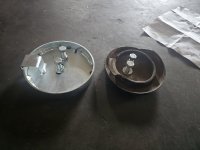The factory coil cup is designed to have a relief formed into the coil base to allow for full support of the last coil "pigtail" as the spring is formed. It is also designed to hold the spring securely to the radius arm.
I would surmise that the design engineer and process engineering team in Operations worked together in a DFM solution that allowed Dana Spicer to provide the axle housing with brakes to a sub-assembly team that would attach the radius arms, bushings, coil cups, track bar, steering linkage and shocks to the axle assembly. The use of a positive retention device to secure the coil springs prior to assembly was probably considered a DFM imperative. Otherwise the springs could fall out and cause delay as well as potential injury. It also provides some level of rotational stability so that the spring cannot spin once it is clamped. This would likely decrease installation time and variability during assembly.
The Duff / WH solution is optimized for coil cup strength. But it provides an inferior spring landing area, and the spring is not secure when the axle assembly is not in frame. The lack of a formed coil bucket will result in unfavorable NVH (Noise, Vibration, Harshness) and increased corrosion potential at the contact line. It will also create a complex non-linearity in the coil spring rate when the spring is partially loaded. I imagine it's largely indeterminate as the load approaches 0. It means nothing from a practical perspective, but it goes against "best practices" in coil spring application engineering. Usually when a coil spring lands on a flat pad, the last coil is wound flat, or the pigtail is machined flat.
So is it a problem or concern for ANYBODY? Yes. Certainly.
Is it a problem for YOU? Nope.












